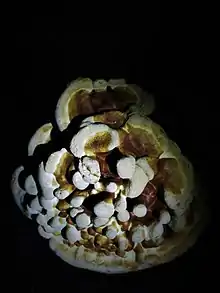| Ganoderma multipileum | |
|---|---|
 | |
| Scientific classification | |
| Domain: | Eukaryota |
| Kingdom: | Fungi |
| Division: | Basidiomycota |
| Class: | Agaricomycetes |
| Order: | Polyporales |
| Family: | Ganodermataceae |
| Genus: | Ganoderma |
| Species: | G. multipileum |
| Binomial name | |
| Ganoderma multipileum Ding Hou (1950) | |
| Ganoderma multipileum | |
|---|---|
| Pores on hymenium | |
| Cap is offset or indistinct | |
| Hymenium attachment is irregular or not applicable | |
| Stipe is bare or lacks a stipe | |
| Spore print is brown | |
| Ecology is saprotrophic or parasitic | |
| Edibility is edible | |
Ganoderma multipileum, commonly known as lingzhi or chizhi, is a species of polypore mushroom found in tropical Asia. It has been used as a medicinal mushroom for over 2000 years. Formerly known as Ganoderma lucidum, phylogenetic analyses published in 2009 revealed that G. lucidum is primarily a European species, and that the name has been incorrectly applied to Asian collections.[1]
References
- ↑ Wang DM, Wu SH, Su CH, Peng JT, Shih YH, Chen LC (2009). "Ganoderma multipileum, the correct name for G. lucidum in tropical Asia". Botanical Studies. 50 (4): 451–58.
External links
This article is issued from Wikipedia. The text is licensed under Creative Commons - Attribution - Sharealike. Additional terms may apply for the media files.